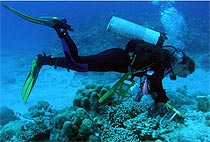VELS - Allowing marine studies to come to life
What I learned at the courses of 2005
Getting Wet
As a teacher and scuba instructor I have long enjoyed the wonders of the oceans and sharing these with others. Over recent years this enjoyment has become more of a passion as my practical knowledge of what I am looking at has increased.
| 
Figure 2: Setting up a transect line
at Osprey Reef. |
| My work within the CUE Program, Year 8 Science Program and Year 10 Global Sustainability Course has led me to discover more about this type of ecosystem, about the animals and plants that live and interact there, and has increased our understanding of this environment and its sustainability. Over the last year I have had the opportunity to do a course on marine monitoring and attend a conference on the health of corals and how to monitor the sub-tidal area. |
| |
|
| Going Deep During the first course we where taught the protocols to carry out a fish, invertebrate and substrate survey. This is done in a rectangle area a 100 meters long, 5 meters wide and 5 meters high.
| 
Click for larger image |
| |
| In their five year report, “The global coral reef crisis, trends and solutions”, Reef Check states, “The goal of this monitoring is to detect ecologically and statistically significant changes on coral reefs that are caused by human activities. A set of biological indicators was chosen to serve individually as indicators of specific types of anthropogenic impacts and collectively as a proxy for ecosystem health. The organisms where chosen for both ecological and economic value and together were meant to provide an ecoholistic representation of key coral life.”
The survey, for the pacific region, looks at ten types of fish and any rare fish sighted, 22 Invertebrates, 12 impacts and you record the substrate every 50cm. A copy of the three survey sheets are included at the end of this report.
Taking part in a Reef Check survey allows you to see the reef in a different way. I spent several hours during the course diving looking for invertebrate animals that are used as indicators of the health of the reef as well as those that threaten the reef. Along with all of the colour and natural aspects of the reef system we also found the obvious signs of stress due to global warming, over fishing and pollutants.
The training and doing a survey of this nature is very demanding and the course was an intense 6 days with pre-reading and identification exercises that had to be done before the course started. We finished the course with a 400 question identification exam and had to do a complete survey and a video survey. This was an excellent course and increased my knowledge of life on coral reefs tenfold.
|
It is important that research organizations like Reef Check are able to train others. Organizations’, like Reef Check and Coral Cay, rely on either paying volunteers’ or donations from the private sector to run their organizations and they can’t, due to there size, actually monitor many of the worlds reefs themselves. So that they can cover more reefs they need groups like students who are interested to be trained and report back to them the results of surveys, and so the organizations can get a better view of the world’s reefs.
Coral Cay spends 2 full weeks training its monitors, while as I have said, the Reef Check course with only 2 people on it was a solid 6 days with pre-reading and exams. This makes it difficult to teach and train Year 9 students, however it is important for students to see the full monitoring system that is required.
|